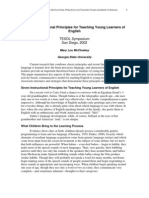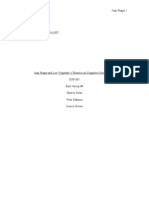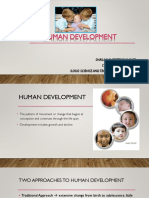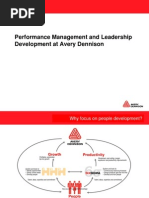Vygotsky & Piaget
Vygotsky & Piaget
Uploaded by
dec493Copyright:
Available Formats
Vygotsky & Piaget
Vygotsky & Piaget
Uploaded by
dec493Copyright
Available Formats
Share this document
Did you find this document useful?
Is this content inappropriate?
Copyright:
Available Formats
Vygotsky & Piaget
Vygotsky & Piaget
Uploaded by
dec493Copyright:
Available Formats
AP Psychology Term 2 Project Carrie Brown Period 7 Piaget vs.
Vygotsky Child Psychologists of The Century Jean Piaget was a French biologist, who later moved on to child development and psychology. He rewrote English intelligence tests in French and became interested in why children answered the way they did when questioned about their wrong answers. His studies were done primarily through observation and conversation with his own children, which would later lead to much criticism. Lev Vygotsky was a Russian psychologist who lived during the Russian revolution. He wrote six books within about ten years. The books varied in topic, but still focused heavily on child development and education. He firmly believed in language being one of the biggest factors in learning and developing. Lev Vygotsky and Jean-Jacques Piagets' theories are similar in that they are both very much focused on child development in stages. They differ in how they focus on said development. Vygotsky states that fluid social interaction and understanding speech and language and being able to speak is absolutely necessary for learning, which he often referred to as making meaning. Piaget states that learning just naturally occurs through maturation in everyday experience. He focused more on when to teach certain concepts, while Vygotsky focused more on what those certain concepts to teach would be and how to teach them to the appropriate age group. Vygotsky and Piaget both have multiple stages in their theories and they both shared
the idea of the theory of mind. Theory of mind is a person's idea of the mental state of them self and others around them. Theory of mind is something that develops more and more through every stage, growing through out the entire life span, in both theories. Even with the above similarities in their theories, they both had very different and individual ideas. Piaget said we build thought in schemas, which are an organized way of putting our thoughts and information together, for example, a young child may see an image of a horse in a book, then later see a horse at a zoo and ask it's parent if the creature is a horse. The parent tells the child that the animal is indeed a horse and the child remembers that it has two ears, four legs, a long tail, whinneys and neighs, and is shorthaired. The child then sees a zebra in the same zoo and asks the parent if it is a horse, but the parent corrects the child, telling it that the animal is in fact a zebra. The child then understands that a zebra, while similar to a horse, is different because it has a different fur pattern and makes different sounds. In this scenario, the child has experienced both assimilation, the addition of new information into an existing schema, and accommodation, the remembrance of old information in the formation of a new schema. A concept Vygotsky advocated, was scaffolding. He stated that a more knowledgeable other, someone or something that knows more than the student, can help encourage learning by assisting in such a way as to help the student solve the problem perhaps by giving a clue that still requires thinking or asking another question that could aid in the solution of the original problem. The answer is not simply given away, it must still be found by the student. The information gained with the help of the more knowledgeable other is in the zone of proximal development, which is between the known and unknown.
Piaget's theory on development has four distinct stages. The first stage is the sensorimotor period from birth through the first two years. In this stage, the infant takes in information primarily through touching things, especially by putting objects in its mouth. The infant is more afraid of strangers than it will be as it ages and it gains object permanence, which is the knowledge that something exists even when it is out of site. Once object permanence has been reached, the infantile game of peek-a-boo is no longer as exciting. The second portion of Piaget's theory is the pre-operational stage, going from about two to seven years of age. In this time span, the child is capable of speech and communication, but can not fully understand all logic. By the end of this stage, the child will understand the idea of conservation, which is a concept that states that properties remain the same in a different form. For example, the child may think that a tall, narrow glass of juice has more in it that a shorter, wider glass has even though the two glasses have equal volume. The child will also become much less egocentric in this time, meaning he or she will be able to view situations from another individual's perspective more easily. The third stage is the concrete operational stage, spanning from the ages of seven to eleven. In those years, the preteen will gain the ability to logically think about ideas, but are not yet capable of abstract thought. The last stage of Piaget's theory, the fourth, is the formal operational stage. It begins around age eleven and continues through out life. In this stage, the individual will eventually be able to think about abstract ideas and concepts. In Vygotsky's theory, the stages are often times referred to as periods of critical development. Each period has a crisis which must be resolved before the next period can be reached. If a crisis is not resolved, an unhealthy mental state can be the result. The first
crisis is immediate at birth. The infant is physically separate from it's mother, but still depends on her for life. The second crisis is reached around the twelfth month. The child must grow to communicate and move itself effectively to survive as efficiently as possible. The next crisis is reached around three years of age. The toddler wants to have his or her own personality, but is unsure of how to do so. The child must learn to become more independent. The fourth stage occurs around the age of seven. The child knows he or she must be more mature in thought and not think so childishly to solve his or her problems. The fifth and final crisis is often times around age thirteen, when the child is nearing the onset of puberty. Educational systems are very influenced by both of these theories. Piaget's studies are very influential in when to teach certain material, while Vygotsky's studies are more influential in what that certain material is, and how to teach it to the appropriate age group. For instance, it would not be wise to teach quantum mechanics to a first grade class when they do not yet understand basic addition. Although both theorists are very influential in western education, they also both have many criticisms. In Piaget's case, his studies were very open to bias because he studied his own children, his friends' children, and the friends of his children. He also studied them individually, so they were unaffected by peers. Vygotsky, on the other hand, didn't pay close enough attention to developmental issues. In addition, his idea of the Zone of Proximal Development, while a good concept, is rather vague.
http://www.simplypsychology.org/vygotsky.html http://www.ethicalpolitics.org/wits/vygotsky-development.pdf http://www.instructionaldesign.org/theories/social-development.html http://www.learningandteaching.info/learning/piaget.htm http://www2.honolulu.hawaii.edu/facdev/guidebk/teachtip/piaget.htm http://www.simplypsychology.org/piaget.html The Moral Development of The Child by Jean Piaget Vygotsky's Developmental and Educational Psychology by Peter E. Langford
You might also like
- The Development of The Social and Academic Identities of International Students in English Speaking Higher Education InstitutionsDocument23 pagesThe Development of The Social and Academic Identities of International Students in English Speaking Higher Education InstitutionsDita Noor Fitriani50% (2)
- OBSERVINGDocument2 pagesOBSERVINGCherry Casamplong83% (6)
- Graduate Comparative Analysis EssayDocument10 pagesGraduate Comparative Analysis Essayapi-285912724No ratings yet
- Comparing Learning Theories Using The Dent-Read and Zukow-Goldring LearnerEnvironment MatrixDocument7 pagesComparing Learning Theories Using The Dent-Read and Zukow-Goldring LearnerEnvironment MatrixtracycwNo ratings yet
- ASQ Realtests CMQ-OE v2015-03-27 by Irma 150q PDFDocument68 pagesASQ Realtests CMQ-OE v2015-03-27 by Irma 150q PDFKabala UsmanNo ratings yet
- JFWTC Toastmasters Club Newsletter: ConverseDocument22 pagesJFWTC Toastmasters Club Newsletter: ConverseamjudNo ratings yet
- Bruner - Learning Theory in EducationDocument5 pagesBruner - Learning Theory in EducationHelen YangNo ratings yet
- Piaget and Cognitive DevelopmentDocument38 pagesPiaget and Cognitive DevelopmentJuan Paz SantosNo ratings yet
- Alexandra Essay PiagetDocument9 pagesAlexandra Essay Piagetapi-427522957No ratings yet
- Description of Krashen's Theory of Second Language AcquisitionDocument3 pagesDescription of Krashen's Theory of Second Language Acquisitionherlinda_effNo ratings yet
- Early Childhood Period of Development EportfolioDocument3 pagesEarly Childhood Period of Development Eportfolioapi-367895274No ratings yet
- McCloskey TESOL Symposium02Document13 pagesMcCloskey TESOL Symposium02pardiemasNo ratings yet
- Understanding Children's Development - Volume 3Document10 pagesUnderstanding Children's Development - Volume 3DiniNo ratings yet
- R1 Jean Piaget & Lev Vygotsky Cognitive DevelopmentDocument14 pagesR1 Jean Piaget & Lev Vygotsky Cognitive DevelopmentJoemarie PailanNo ratings yet
- The Case Against Bilingual and Multilingual Education in South Africa, Laying Bare The Myths PDFDocument26 pagesThe Case Against Bilingual and Multilingual Education in South Africa, Laying Bare The Myths PDFNaziem MoosNo ratings yet
- ApprochesDocument11 pagesApprochesmavericksailorNo ratings yet
- Vygotsky's Sociocultural Theory - Group 6 FINALDocument50 pagesVygotsky's Sociocultural Theory - Group 6 FINALQuynh TranNo ratings yet
- Factors of Human DevelopmentDocument5 pagesFactors of Human DevelopmentKarmelaÜCastilloNo ratings yet
- 2.5-History of Early Childhood EducationDocument4 pages2.5-History of Early Childhood EducationAnum Iqbal100% (1)
- Expressive Language (Using Words and Language) : Print PDFDocument8 pagesExpressive Language (Using Words and Language) : Print PDFNico Corporal CañaveralNo ratings yet
- Johann PestalozziDocument14 pagesJohann PestalozzijsdgjdNo ratings yet
- (SpringerBriefs in Education) Terence Lovat - The Art and Heart of Good Teaching - Values As The Pedagogy-Springer Sinpore (2019) - DikonversiDocument88 pages(SpringerBriefs in Education) Terence Lovat - The Art and Heart of Good Teaching - Values As The Pedagogy-Springer Sinpore (2019) - DikonversiJhon AndreyNo ratings yet
- The Heart of Authentic AssessmentDocument54 pagesThe Heart of Authentic AssessmentVeera KunasegaranNo ratings yet
- Emotions As A TeacherDocument7 pagesEmotions As A TeacherCindy McknightNo ratings yet
- Importance of Social InteractionsDocument2 pagesImportance of Social InteractionsbubblymunirNo ratings yet
- Jean Piaget BiographyDocument2 pagesJean Piaget Biographycitlali100% (1)
- Child MilestoneDocument11 pagesChild MilestoneLaiba100% (2)
- Observation of A ChildDocument2 pagesObservation of A Childapi-339283791No ratings yet
- hUMANISTIC APPROACHDocument12 pageshUMANISTIC APPROACHAminath Maana Ibrahim ShakeeNo ratings yet
- Chapter 10 EarlyLanguageAcquisitionDocument21 pagesChapter 10 EarlyLanguageAcquisitionRandi Or0% (1)
- Warm UpDocument8 pagesWarm UpmarioNo ratings yet
- A New Approach To Teaching? Flipped LearningDocument2 pagesA New Approach To Teaching? Flipped LearningRya Earl100% (1)
- The Educator's Playbook:: Teaching Critical Thinking in Today's WorldDocument15 pagesThe Educator's Playbook:: Teaching Critical Thinking in Today's WorldLinh DoNo ratings yet
- Tutoria Topping (2000)Document36 pagesTutoria Topping (2000)jrdiasmailNo ratings yet
- Ed 110 Classroom Management Plan - Mandi ThomasDocument15 pagesEd 110 Classroom Management Plan - Mandi Thomasapi-455398729No ratings yet
- 1st Language Acquisition: How Do Humans Acquire Speech?Document39 pages1st Language Acquisition: How Do Humans Acquire Speech?AncuZza B.No ratings yet
- Students With Learning Disabilities at University: Sandra ZecchiDocument8 pagesStudents With Learning Disabilities at University: Sandra ZecchiCesar VargasNo ratings yet
- Speech Sound DisorderDocument2 pagesSpeech Sound DisorderVindo PurbaNo ratings yet
- French Wedding TraditionsDocument14 pagesFrench Wedding TraditionsТатьяна ВороноваNo ratings yet
- Kohlberg's Theory of Moral DevelopmentDocument8 pagesKohlberg's Theory of Moral DevelopmentNavin MehtaNo ratings yet
- Capstone Assignment Ecd 470Document8 pagesCapstone Assignment Ecd 470api-341533986No ratings yet
- MTBase - Multilingual Education PDFDocument8 pagesMTBase - Multilingual Education PDFcashielle arellanoNo ratings yet
- Piaget Vs VygotskyDocument9 pagesPiaget Vs Vygotskyapi-272037951100% (3)
- Developmental Delay Fact SheetDocument4 pagesDevelopmental Delay Fact SheetNational Dissemination Center for Children with DisabilitiesNo ratings yet
- Cia 1 DevelopmentalDocument16 pagesCia 1 DevelopmentalPranjal SuranaNo ratings yet
- By: Elizabeth W. SantosDocument125 pagesBy: Elizabeth W. SantosMarie Joy GarmingNo ratings yet
- Communicative CompetenceDocument36 pagesCommunicative CompetenceAnnisa Ratna Purwanti100% (1)
- Experiential Learning in BriefDocument6 pagesExperiential Learning in Briefmgalal55No ratings yet
- Lo3 Artifact - Micro-Counseling Skills Midterm ReflectionDocument6 pagesLo3 Artifact - Micro-Counseling Skills Midterm Reflectionapi-543749170No ratings yet
- Intellectual Disabi Lity.: Indira 211701035Document61 pagesIntellectual Disabi Lity.: Indira 211701035Monicca GVNo ratings yet
- Individual Investigation of A Learning Theory Aboriginal PedagogyDocument12 pagesIndividual Investigation of A Learning Theory Aboriginal Pedagogyapi-249749598No ratings yet
- Rousseau On EducationsDocument8 pagesRousseau On Educationsamin jamalNo ratings yet
- Lesson 3 Nature of A Science LearnersDocument11 pagesLesson 3 Nature of A Science LearnersJoann Balmedina100% (1)
- Senior Project Paper-5Document10 pagesSenior Project Paper-5api-409933006100% (1)
- Ethical Considerations in Child Research in Light of The Convention On The Rights of The ChildDocument16 pagesEthical Considerations in Child Research in Light of The Convention On The Rights of The Childjgcgeditor100% (3)
- PiagetDocument11 pagesPiagetjkmil100% (1)
- Jean Piaget's Theory of Cognitive Development Hand OutsDocument3 pagesJean Piaget's Theory of Cognitive Development Hand OutsBrenda Gwen Marie BenedictoNo ratings yet
- Social Constructivism - VygotskyDocument18 pagesSocial Constructivism - VygotskySabali TsofelaNo ratings yet
- C 2: Learning TheoriesDocument9 pagesC 2: Learning TheoriessgjrstujtiNo ratings yet
- 1 Basic Concepts and Issues On Human DevelopmentDocument28 pages1 Basic Concepts and Issues On Human DevelopmentShailini GestosaniNo ratings yet
- Educ 1 - 6Document34 pagesEduc 1 - 6Rolando T. Jaravata Jr.No ratings yet
- The Developing ChildDocument20 pagesThe Developing Childzulkifli100% (1)
- Jean PiagetDocument8 pagesJean PiagetMarjorie MalvedaNo ratings yet
- Benefits of IEEE Membership-PresentationDocument13 pagesBenefits of IEEE Membership-PresentationCh Srinivasa Reddy100% (1)
- Brother Rice "Be Exceptional" Achievement Awards - Spring, 2019Document16 pagesBrother Rice "Be Exceptional" Achievement Awards - Spring, 2019brotherriceNo ratings yet
- Foreign and Second Language AnxietyDocument14 pagesForeign and Second Language Anxietydariya.tg.02No ratings yet
- Prospectus 2023-25 JvsU4a0Document29 pagesProspectus 2023-25 JvsU4a0Sumit RanjanNo ratings yet
- Detailed Lesson Plan in EnglishDocument9 pagesDetailed Lesson Plan in Englisherelyn docuyananNo ratings yet
- Lesson 16 Theme Descriptive Language To Create An AtmosphereDocument3 pagesLesson 16 Theme Descriptive Language To Create An AtmosphereTalant KanatovNo ratings yet
- Project Charter - Sample 2Document3 pagesProject Charter - Sample 2Smart SaadNo ratings yet
- Common Entrance ExamDocument2 pagesCommon Entrance ExamdheerajNo ratings yet
- Banana ASTI Case Study PDFDocument119 pagesBanana ASTI Case Study PDFSharon Rose GalopeNo ratings yet
- Resume Format - ADocument3 pagesResume Format - Anehanayaka25No ratings yet
- AhpraDocument5 pagesAhpraapi-430605312100% (1)
- Ensayo Sobre La Brecha GeneracionalDocument8 pagesEnsayo Sobre La Brecha Generacionalsbaoljwlf100% (1)
- English10 Q4 Module 1 3Document31 pagesEnglish10 Q4 Module 1 3Angie100% (1)
- Engla210 ReportDocument2 pagesEngla210 Reportohood781No ratings yet
- Motions For Debate 2019Document4 pagesMotions For Debate 2019Saharsh ChitranshNo ratings yet
- E-Learning Methodologies and Tools PDFDocument5 pagesE-Learning Methodologies and Tools PDFSion SlsNo ratings yet
- LDR & GPS OverviewDocument21 pagesLDR & GPS OverviewVo Thanh ThangNo ratings yet
- Patient Safety Law Policy and Practice 1st Edition John Tingle All Chapter Instant DownloadDocument84 pagesPatient Safety Law Policy and Practice 1st Edition John Tingle All Chapter Instant Downloaddahlarnereng6100% (2)
- Objective 7Document2 pagesObjective 7Ehlee TubalinalNo ratings yet
- Twine UnitDocument4 pagesTwine UnitMegan KalinaNo ratings yet
- List and Explain The Use of Six Strategies For Improving Verbal Communication AnswerDocument2 pagesList and Explain The Use of Six Strategies For Improving Verbal Communication AnswerVikram KumarNo ratings yet
- SL:no Name AGE F Name Designation Id:No Mobile NoDocument7 pagesSL:no Name AGE F Name Designation Id:No Mobile NoMd:mydul IslamNo ratings yet
- Request Letter To SisterDocument9 pagesRequest Letter To SisterAbdullah MundasNo ratings yet
- Tam Tutorial LetterDocument14 pagesTam Tutorial LetterSiwe NhlapoNo ratings yet
- "I" Is For Ideal: Learning ObjectivesDocument5 pages"I" Is For Ideal: Learning ObjectivesPost Your FeedbackNo ratings yet
- Assignment 2Document12 pagesAssignment 2api-426615858No ratings yet
- Spring 2011 Runnymede Bulletin (Arts & Culture)Document32 pagesSpring 2011 Runnymede Bulletin (Arts & Culture)RunnymedeTrustNo ratings yet

























































































